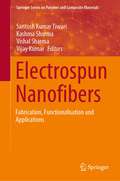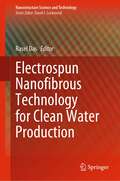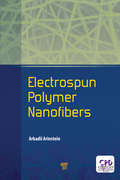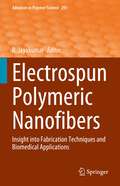- Table View
- List View
Electroresponsive Molecular and Polymeric Systems: Volume 2: (Electroresponsive Molecular/polymeric Systems Ser.)
by Terje A. SkotheimThis volume focuses on the developments in theory and materials science of conjugated materials for nonlinear optics, and on the processing of conjugated polymers. It describes the microscopic origin and mechanism of the nonlinear optical susceptibilities in the framework of quantum field theory.
Electroresponsive Molecular and Polymeric Systems: Volume 1:
by Terje A. SkotheimThis book provides an overview of the state of the art of several of the subfields of electroresponsive polymer science. It also provides a sufficiently broad perspective to stimulate development in new direction and to bring researchers up to date on the fields as a whole.
Electroresponsive Molecular and Polymeric Systems: Volume 1:
by Terje A. SkotheimThis book provides an overview of the state of the art of several of the subfields of electroresponsive polymer science. It also provides a sufficiently broad perspective to stimulate development in new direction and to bring researchers up to date on the fields as a whole.
Electroresponsive Molecular and Polymeric Systems: Volume 2: (Electroresponsive Molecular/polymeric Systems Ser. #2)
by Terje A. SkotheimThis volume focuses on the developments in theory and materials science of conjugated materials for nonlinear optics, and on the processing of conjugated polymers. It describes the microscopic origin and mechanism of the nonlinear optical susceptibilities in the framework of quantum field theory.
Electrorheological Fluids: Modeling and Mathematical Theory (Lecture Notes in Mathematics #1748)
by Michael RuzickaThis is the first book to present a model, based on rational mechanics of electrorheological fluids, that takes into account the complex interactions between the electromagnetic fields and the moving liquid. Several constitutive relations for the Cauchy stress tensor are discussed. The main part of the book is devoted to a mathematical investigation of a model possessing shear-dependent viscosities, proving the existence and uniqueness of weak and strong solutions for the steady and the unsteady case. The PDS systems investigated possess so-called non-standard growth conditions. Existence results for elliptic systems with non-standard growth conditions and with a nontrivial nonlinear r.h.s. and the first ever results for parabolic systems with a non-standard growth conditions are given for the first time. Written for advanced graduate students, as well as for researchers in the field, the discussion of both the modeling and the mathematics is self-contained.
Electroslag Technology (Materials Research and Engineering)
by B. I. Medovar G. A. BoykoDr. Boris Medovar, a member of the Soviet Academy of Sciences, is a promi nent member of the E.O. Paton Electric Welding Institute in Kiev, one of the pre-eminent institutes of the USSR. The Paton Institute, internationally famous for its entrepreneurial efforts in electrical welding processes, is also famous for its application of electrically based processes in melting and remelting of high alloy and high-temperature materials. These include the ESR (electroslag re melting) process, the ESC (electroslag casting) process, skull remelting based on electron-beam processes, plasma arc processes, and electric arc processes. Along with the ESR process for ingot production is the commercial plasma arc remelt process for specialty steels, particularly where high nitrogen contents may be desired, as in austenitic stainless steels. Major industrial centers are now scattered throughout the USSR and are a major factor in high-alloy, high strength, low- and high-temperature materials. The ESR process was developed in response to the Western development of the VAR (vacuum arc remelting) process for producing very highly alloyed materials during the growth period of the jet engine age. The V AR and ESR processes utilize different purification and refinement processes that are extremely critical in very highly, complexly alloyed superalloys and high-speed tool steels. In water-cooled remelt systems, they also achieve relatively rapid (directional) solidification, minimizing segregation and coarse phase separation of undesir able impurity elements or elements that tend to form coarse brittle phases.
Electrosorption
by Eliezer GileadiThe gradual emergence during the last decade of the study of the mechanism of electrode reactions from the dark ages has given stimulus to a consideration of the double layer at metal-solution interfaces, which extends far outside the classical experimental studies of the capacitance of the mercury solution interface made during the 1950's by D. C. Grahame at Amherst College, Massachusetts. The central aspect of the study of an electrode reaction is the elucidation of its path and rate-determining step. Two fields are, however, prerequisites for such studies. First, it must be known what species are in the bulk of the solution, for these will seldom be simple ones such as H30~ and this study ("complex ions") has been made with both extent and depth. Second, the occupancy of the surface of the electrocatalyst and the associated field gradients must be known as a function of position in the double layer. Such "maps of the double layer" can be given with reasonable certainty up to concentrations of about 1 N for mercury in contact with solutions of inorganic ions. However, this is-or was until very recently-the extent of the know ledge. The problems confronting a fundamental approach to the rational development of, e.g., fuel cell catalysis were therefore considerable.
Electrospinning for Advanced Energy and Environmental Applications
by Sara CavaliereElectrospinning for Advanced Energy and Environmental Applications delivers a state-of-the-art overview of the use of electrospun fibers in energy conversion and storage, as well as in environmental sensing and remediation. Featuring contributions from leading experts in electrospinning and its specific applications, this book: Introduces the elect
Electrospinning for High Performance Sensors (NanoScience and Technology)
by Antonella Macagnano Emiliano Zampetti Erich KnyThis book aims to present the different aspects of electrospinning for designing and fabricating high performing materials for sensors applied in gaseous and liquid environments. Since electrospinning is a versatile and inexpensive manufacturing technology, the book emphasizes the industrial applications perspective. The volume is an edited collection of the most recent and encouraging results concerning advanced nanostructured (bio) sensors. The feats achieved by these sensors range from high sensitivity to extreme operating conditions and satisfy a wide range of requirements. Most of the contributions in this book come from First International Workshop on Electrospinning for High Performance Sensing (EHPS2014) that was held in Rome in 2014, as part of the European COST Action MP1206 Electrospun Nanofibres for bio inspired composite materials and innovative industrial applications.
Electrospray and MALDI Mass Spectrometry: Fundamentals, Instrumentation, Practicalities, and Biological Applications
by Richard B. ColeDiscover how advances in mass spectrometry are fueling new discoveries across a broad range of research areas Electrospray and MALDI Mass Spectrometry brings both veteran practitioners and beginning scientists up to date with the most recent trends and findings in electrospray ionization and matrix-assisted laser desorption/ionization (MALDI) mass spectrometry. In particular, this Second Edition highlights how advances in electrospray and MALDI mass spectrometry are supporting important discoveries in new and emerging fields such as proteomics and metabolomics as well as in traditional areas of chemistry and physics research. Electrospray AND MALDI Mass Spectrometry, SECOND EDITION is divided into five parts: Part A, Fundamentals of ES, explains the fundamental phenomena underlying the electrospray process, including selectivity in ionization and inherent electrochemistry, and concludes with a chapter offering a comparative inventory of source hardware Part B, Fundamentals of MALDI, confronts ionization mechanisms, instrument development, and matrix selection, and includes a final chapter that explores the special application of MALDI to obtain two-dimensional images of spatial distributions of compounds on surfaces Part C, ES and MALDI Coupling to Mass Spectrometry Instrumentation, examines the coupling of these ionization techniques to various mass analyzers, including quadrupole ion trap, time-of-flight, Fourier transform ion cyclotron resonance, and ion mobility mass spectrometers Part D, Practical Aspects of ES and MALDI, investigates analytical issues including quantification, charge-state distributions, noncovalent interactions in solution that are preserved as gas-phase ions, and various means of ion excitation in preparation for tandem mass spectrometry, and offers a guide to the interpretation of even-electron mass spectra Part E, Biological Applications of ES and MALDI, examines the role of mass spectrometry in such areas as peptide and protein characterization, carbohydrate analysis, lipid analysis, and drug discovery Written by a team of leading experts, the book not only provides a critical review of the literature, but also presents key concepts in tutorial fashion to help readers take full advantage of the latest technological breakthroughs and applications. As a result, Electrospray and MALDI Mass Spectrometry will help researchers fully leverage the power of electrospray and MALDI mass spectrometry. The judicious compartmentalization of chapters, and the pedagogic presentation style throughout, render the book highly suitable for use as a text for graduate-level courses in advanced mass spectrometry.
Electrospray and MALDI Mass Spectrometry: Fundamentals, Instrumentation, Practicalities, and Biological Applications
by Richard B. ColeDiscover how advances in mass spectrometry are fueling new discoveries across a broad range of research areas Electrospray and MALDI Mass Spectrometry brings both veteran practitioners and beginning scientists up to date with the most recent trends and findings in electrospray ionization and matrix-assisted laser desorption/ionization (MALDI) mass spectrometry. In particular, this Second Edition highlights how advances in electrospray and MALDI mass spectrometry are supporting important discoveries in new and emerging fields such as proteomics and metabolomics as well as in traditional areas of chemistry and physics research. Electrospray AND MALDI Mass Spectrometry, SECOND EDITION is divided into five parts: Part A, Fundamentals of ES, explains the fundamental phenomena underlying the electrospray process, including selectivity in ionization and inherent electrochemistry, and concludes with a chapter offering a comparative inventory of source hardware Part B, Fundamentals of MALDI, confronts ionization mechanisms, instrument development, and matrix selection, and includes a final chapter that explores the special application of MALDI to obtain two-dimensional images of spatial distributions of compounds on surfaces Part C, ES and MALDI Coupling to Mass Spectrometry Instrumentation, examines the coupling of these ionization techniques to various mass analyzers, including quadrupole ion trap, time-of-flight, Fourier transform ion cyclotron resonance, and ion mobility mass spectrometers Part D, Practical Aspects of ES and MALDI, investigates analytical issues including quantification, charge-state distributions, noncovalent interactions in solution that are preserved as gas-phase ions, and various means of ion excitation in preparation for tandem mass spectrometry, and offers a guide to the interpretation of even-electron mass spectra Part E, Biological Applications of ES and MALDI, examines the role of mass spectrometry in such areas as peptide and protein characterization, carbohydrate analysis, lipid analysis, and drug discovery Written by a team of leading experts, the book not only provides a critical review of the literature, but also presents key concepts in tutorial fashion to help readers take full advantage of the latest technological breakthroughs and applications. As a result, Electrospray and MALDI Mass Spectrometry will help researchers fully leverage the power of electrospray and MALDI mass spectrometry. The judicious compartmentalization of chapters, and the pedagogic presentation style throughout, render the book highly suitable for use as a text for graduate-level courses in advanced mass spectrometry.
Electrospun Biomaterials and Related Technologies
by Jorge AlmodovarThis books provides a compendium of electrospinning strategies and related technologies for the production of biomaterials for tissue engineering and regenerative medicine applications. It gives a broad overview of the field as well as cutting-edge research on electrospinning and how it is applied to engineer biomaterials. This is an ideal book for biomaterials scientists, engineers, students, and researchers. This book also: Presents cutting-edge research performed in the area of electrospinning with applications in tissue engineering and regenerative medicineProvides readers from the biomaterials field as well as those new to the field with a broad overview of the multiple applications of electrospun biomaterialsSummarizes the latest research from the past ten years on electrospinning and related technologies
Electrospun Nanofibers: Fabrication, Functionalisation and Applications (Springer Series on Polymer and Composite Materials)
by Santosh Kumar Tiwari Kashma Sharma Vishal Sharma Vijay KumarThe book provides an up-to-date account of the various techniques of fabrication & functionalization of electrospun nanofibers as well as recent advancements. An overview of the advanced applications of such techniques in different areas is also presented. Both experimental and theoretical approaches related to electrospun nanofibers are covered along with a discussion on the inherent properties of electrospun nanofibers. Therefore, this book provides a unique resource not only to established researchers but also newcomers starting out in this field.
Electrospun Nanofibers for Energy and Environmental Applications (Nanostructure Science and Technology)
by Bin Ding Jianyong YuThis book offers a comprehensive review of the latest advances in developing functional electrospun nanofibers for energy and environmental applications, which include fuel cells, lithium-ion batteries, solar cells, supercapacitors, energy storage materials, sensors, filtration materials, protective clothing, catalysis, structurally-colored fibers, oil spill cleanup, self-cleaning materials, adsorbents, and electromagnetic shielding.This book is aimed at both newcomers and experienced researchers in the field of nanomaterials, especially those who are interested in addressing energy-related and environmental problems with the help of electrospun nanofibers.Bin Ding, PhD, and Jianyong Yu, PhD, are both Professors at the College of Materials Science and Engineering, Donghua University, China.
Electrospun Nanofibers from Bioresources for High-Performance Applications
by Praveen K. M. Rony Thomas Murickan Jobin Joy Hanna J. Maria Jozef T. Haponiuk Sabu ThomasNanofibers are possible solutions for a wide spectrum of research and commercial applications and utilizing inexpensive bio-renewable and agro waste materials to produce nanofibers can lower manufacturing cost via electrospinning. This book explains synthesis of green, biodegradable, and environmentally friendly nanofibers from bioresources, their mechanical and morphological characteristics along with their applications across varied areas. It gives an elaborate idea on conductive polymers for tissue engineering application as well. Features: Provides insight about electrospun nanofibers from green, biodegradable and environmentally friendly bio resources. Reviews surface characterization of electrospun fibers. Covers diversified applications such as cancer treatment, COVID-19 solutions, food packaging applications, textile materials, and flexible electronic devices. Describes the combined use of 3D printing and electrospinning for tissue engineering scaffolds. Includes Melt electrospinning technique and its advantages over Solution electrospinning This book aims at Researchers and Graduate Students in Material Science and Engineering, Environmental Engineering, Chemical Engineering, Electrical Engineering, Mechanical Engineering, and Biomedical Engineering.
Electrospun Nanofibers from Bioresources for High-Performance Applications
by K. M. Praveen Rony Thomas Murickan Jobin Joy Hanna J. Maria Jozef T. Haponiuk Sabu ThomasNanofibers are possible solutions for a wide spectrum of research and commercial applications and utilizing inexpensive bio-renewable and agro waste materials to produce nanofibers can lower manufacturing cost via electrospinning. This book explains synthesis of green, biodegradable, and environmentally friendly nanofibers from bioresources, their mechanical and morphological characteristics along with their applications across varied areas. It gives an elaborate idea on conductive polymers for tissue engineering application as well. Features: Provides insight about electrospun nanofibers from green, biodegradable and environmentally friendly bio resources. Reviews surface characterization of electrospun fibers. Covers diversified applications such as cancer treatment, COVID-19 solutions, food packaging applications, textile materials, and flexible electronic devices. Describes the combined use of 3D printing and electrospinning for tissue engineering scaffolds. Includes Melt electrospinning technique and its advantages over Solution electrospinning This book aims at Researchers and Graduate Students in Material Science and Engineering, Environmental Engineering, Chemical Engineering, Electrical Engineering, Mechanical Engineering, and Biomedical Engineering.
Electrospun Nanofibres: Materials, Methods, and Applications
by Chandrasekar Muthukumar Senthilkumar Krishnasamy Senthil Muthu Kumar Thiagamani Mariyappan ShanmugamElectrospinning is a versatile method to synthesize fiber materials. Electrospun Nanofibres: Materials, Methods, and Applications explores the technical aspects of electrospinning methods used to derive a wide range of functional fiber materials and their applications in various technical sectors. As electrospinning is a process that can be modified strategically to achieve different fibers of interest, this book covers the wide spectrum of electrospinning methodologies, such as coaxial, triaxial, emulsion, suspension, electrolyte and gas-assisted spinning processes. It: • Discusses a broad range of materials, including synthetic polymers, biodegradable polymers, metals and their oxides, hybrid materials, nonpolymers, and more. • Reviews different electrospinning methods and combined technologies. • Describes process-related parameters and their influence on material properties and performance. • Examines modeling of the electrospinning process. • Highlights applications across different industries. This book is aimed at researchers, professionals, and advanced students in materials science and engineering.
Electrospun Nanofibres: Materials, Methods, and Applications
by Chandrasekar Muthukumar Senthilkumar Krishnasamy Senthil Muthu Kumar Thiagamani Mariyappan ShanmugamElectrospinning is a versatile method to synthesize fiber materials. Electrospun Nanofibres: Materials, Methods, and Applications explores the technical aspects of electrospinning methods used to derive a wide range of functional fiber materials and their applications in various technical sectors. As electrospinning is a process that can be modified strategically to achieve different fibers of interest, this book covers the wide spectrum of electrospinning methodologies, such as coaxial, triaxial, emulsion, suspension, electrolyte and gas-assisted spinning processes. It: • Discusses a broad range of materials, including synthetic polymers, biodegradable polymers, metals and their oxides, hybrid materials, nonpolymers, and more. • Reviews different electrospinning methods and combined technologies. • Describes process-related parameters and their influence on material properties and performance. • Examines modeling of the electrospinning process. • Highlights applications across different industries. This book is aimed at researchers, professionals, and advanced students in materials science and engineering.
Electrospun Nanofibrous Separator for Enhancing Capacity of Lithium-ion Batteries (Synthesis Lectures on Green Energy and Technology)
by Yifu LiThis book offers an in-depth exploration of battery separators, a critical component in Lithium-ion batteries (LIBs). Serving as insulators between electrodes to prevent internal short circuits, these separators play a crucial role in retaining liquid electrolyte and facilitating the migration of lithium ions during battery cycling. In the face of increasing demand for high-performance LIBs across diverse applications, the development of superior separators is imperative. Among the various advancements in battery separator research, electrospun nanofibrous separators have gained significant attention. These separators exhibit compelling characteristics, including large pore size (typically above 500 nm), high porosity (typically above 70%), and an interconnected porous structure, all of which enhance ion transportation efficiency and battery cycling performance. However, a notable focus in previous studies has been on electrochemical inert materials as battery separators, which do not contribute to the battery's capacity. This book presents a comprehensive study that introduces a novel concept: the development of a redox-active separator based on electrospun polypyrrole (PPy) composite nanofibers to significantly enhance battery capacity. The book begins by exploring the effects of separators on battery performance, providing valuable insights and guidance for separator design. Then, a detailed investigation into the kinetics of in-situ polymerization of PPy with electrospun fibrous membranes as templates follows, shedding light on the mechanisms behind fabricating the proposed separator. Finally, this book presents the fabrication and characterization of the proposed separator, showcasing potential of the separator for enhancing battery capacity. This book is intended for researchers, engineers, and professionals in the field of battery technology, materials science, and electrochemistry. It is also a valuable resource for graduate students and academics seeking advanced insights into the development of high-performance lithium-ion batteries and innovative separator technologies.
Electrospun Nanofibrous Technology for Clean Water Production (Nanostructure Science and Technology)
by Rasel DasThis book covers the remarkable progress in the field of electrospun nanofibrous materials synthesis that has been made in recent years for clean water production. The goal is to offer comprehensive and substantial contents in each chapter, entailing the electrospinning principle, novel materials and methods, properties, characterization, and applications, such as adsorption, catalysis, and membranes. The book is instrumental in terms of showing the scale-up production of desired fibers that ensure the control of the structure–properties relationship for developing effective water treatment technologies. Every chapter ends with a special section for highlighting research challenges and breakthroughs, so that scientists can explore these opportunities and discover new directions for future developments. Material scientists, nanotechnologists, chemists, engineers, water specialists, and environmentalists will be inspired by the information on electrospun nanofibrous materials to be found in the book. The wide variety of new ideas and recommended future reading will encourage early-career scientists working in this field to design new experiments and practices. The book is useful for college and university-level students enrolled in project courses in materials science and related fields.
Electrospun Polymer Nanofibers
by Arkadii ArinsteinDiscussing the electrospinning process, the book covers in great depth the current research interest in nanoscience and nanotechnology, especially electrospinning of polymer nanofibers. The main distinction of the proposed book from others devoted to the electrospinning process is in the consideration of the problem in question from the physical point of view. Focusing on physical aspects, the book contains physical basics regarding the unique features of electrospun polymer nanofibers and the electrospinning resulting in fabrication of these nanofibers.
Electrospun Polymer Nanofibers
by Arkadii ArinsteinDiscussing the electrospinning process, the book covers in great depth the current research interest in nanoscience and nanotechnology, especially electrospinning of polymer nanofibers. The main distinction of the proposed book from others devoted to the electrospinning process is in the consideration of the problem in question from the physical point of view. Focusing on physical aspects, the book contains physical basics regarding the unique features of electrospun polymer nanofibers and the electrospinning resulting in fabrication of these nanofibers.
Electrospun Polymeric Nanofibers: Insight into Fabrication Techniques and Biomedical Applications (Advances in Polymer Science #291)
by R. JayakumarThis volume deals with the various fabrication techniques, surface functionalization and biomedical applications of polymeric fibers possessing different scale and structure. It provides an overview of fabrication techniques such as Co-axial, Centrifugal, Melt and Yarning to procure multiscale, tubular and layered fibrous scaffold employed for biomedical applications. The chapters in this volume discusse the surface/chemical functionalization of fibers which enhance the biological properties of the fibrous scaffolds as well as the development of hybrid, layered and external stimuli-responsive fibrous scaffolds that hold potential application in biosensor and other biomedical fields. In addition, recent advances and applications of polymeric multiscale fibers in tissue engineering, regenerative medicine and drug delivery are presented. The potential use of fibrous scaffolds in bone, neural, tendon/ligament and cardiac tissue engineering, nanofibers as an antimicrobial wound dressing, employed in cancer theragnostics and in the treatment of skin/periodontal infections are discussed. The volume provides expert knowledge on the fabrication techniques, development of different scale and hybrid structure fibers, surface functionalization, layered and external stimuli responsive fibrous scaffolds. It will be beneficial to material/biomaterials scientists, bioengineering and biotechnologists by providing a better understanding on the subject of the innovative applications of fibrous scaffolds in drug delivery, tissue engineering, wound dressings and regenerative medicine.
Electrostatic Accelerators: Fundamentals and Applications (Particle Acceleration and Detection)
by K. Siegbahn Ragnar HellborgElectrostatic accelerators are an important and widespread subgroup within the broad spectrum of modern, large particle acceleration devices. They are specifically designed for applications that require high-quality ion beams in terms of energy stability and emittance at comparatively low energies (a few MeV). Their ability to accelerate virtually any kind of ion over a continuously tunable range of energies makes them a highly versatile tool for investigations in many research fields including, but not limited to, atomic and nuclear spectroscopy, heavy ion reactions, accelerator mass spectroscopy as well as ion-beam analysis and modification. The book is divided into three parts. The first part concisely introduces the field of accelerator technology and techniques that emphasize their major modern applications. The second part treats the electrostatic accelerator per se: its construction and operational principles as well as its maintenance. The third part covers all relevant applications in which electrostatic accelerators are the preferred tool for accelerator-based investigations. Since some topics are common to all types of accelerators, Electrostatic Accelerators will also be of value for those more familiar with other types of accelerators.
Electrostatic and Stereoelectronic Effects in Carbohydrate Chemistry
by Momcilo MiljkovicThe book deals with polar effects in carbohydrates and how these effects control the stereochemistry of carbohydrate reactions. This is important for understanding the mechanisms of certain carbohydrate reactions, including enzymatic reactions such as glycosidases, a very important group of enzymes in living matter. It is also very useful for synthetic carbohydrate chemists who would like to synthesize stereoselectively certain classes of carbohydrates. This book will be a very important source of information for practicing synthetic carbohydrate chemists. The book will also be helpful for organic chemists, or for those studying glycobiology.


















